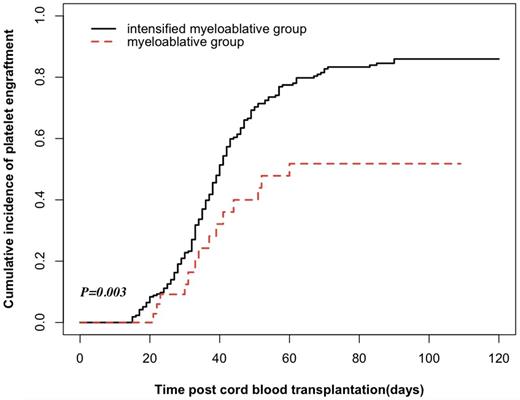Abstract
The superiority and safety of strengthening conditioning regimen for single- unit unrelated cord blood transplantation (sUCBT) in hematological malignancies remain controversial. We retrospectively analyzed the clinical data of 251 hematological malignancies undergoing sUCBT from Apr 2000 to Dec 2014 at Department of hematology in Anhui Provincial Hospital. Out of the 251 patients, 216 received the intensified myeloablative conditioning regimen (IMCR), and 35 received the myeloablative conditioning regimen (MCR). We evaluated the effect of IMCR without using Antithymocyte globulin (ATG) on patient outcomes. The cumulative incidence of myeloid and platelet engraftment of the IMCR group was significantly higher than that in the MCR group (96.98% vs. 82.81%, 85.89% vs. 51.79%, P=0.000 and 0.003, respectively). Corresponding incidences of transplantation-related mortality (TRM) by 180 days in the IMCR group and the MCR group were 19.50% vs. 41.67% (P=0.003), respectively. There were no differences in the incidence of grade II to IV acute GVHD (aGVDH), grade III to IV aGVHD and 2-year cumulative incidence of relapse. Up to Dec. 2015, with a median follow-up of 30 months, the estimated 3-year overall survival and disease- free survival in the IMCR group were both significantly higher than that of the MCR group (64.8% vs. 35.5%, 61.6% vs. 35.5%, P=0.000 and 0.001, respectively). This study is the first to show the superiority of intensified myeloablative regimen to conventional myeloablative regimen.A large-scale prospective study was needed.
(A)
(B)
The cumulative incidence of neutrophil and platelet engraftment of the IMCR group and MCR group. (A)The cumulative incidence of neutrophil engraftment of the IMCR group was predominantly higher than that in the MCR group(96.98% vs. 82.81%, P=0.000). (B)The cumulative incidence of platelet engraftment of the IMCR group was also higher than that in the MCR group(85.89% vs. 51.79%, P=0.003).
The cumulative incidence of neutrophil and platelet engraftment of the IMCR group and MCR group. (A)The cumulative incidence of neutrophil engraftment of the IMCR group was predominantly higher than that in the MCR group(96.98% vs. 82.81%, P=0.000). (B)The cumulative incidence of platelet engraftment of the IMCR group was also higher than that in the MCR group(85.89% vs. 51.79%, P=0.003).
Comparison of the incidence of 3-year OS between the IMCR group and the MCR group.The incidence of 3-year OS of the IMCR group is predominantly higher than that of the MCR group(62.4% vs. 35.5%,P=0.001).
Comparison of the incidence of 3-year OS between the IMCR group and the MCR group.The incidence of 3-year OS of the IMCR group is predominantly higher than that of the MCR group(62.4% vs. 35.5%,P=0.001).
No relevant conflicts of interest to declare.
Author notes
Asterisk with author names denotes non-ASH members.




This feature is available to Subscribers Only
Sign In or Create an Account Close Modal